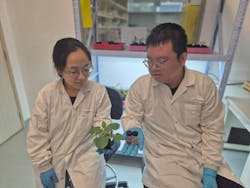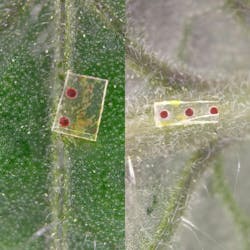First-of-its-kind chromatic sensor detects plant distress
Researchers at the Disruptive and Sustainable Technologies for Agricultural Precision (DiSTAP) interdisciplinary research group—part of the Singapore-MIT Alliance for Research and Technology (SMART)—together with teams from MIT and the Temasek Life Sciences Laboratory (Singapore) developed chromatic sensors to detect drought stress in living plants via changes in their physiological pH levels (see video).
“As agricultural challenges continue to mount, driven by climate change, rising costs, and limited land space, farmers often struggle to take proactive action or detect issues early enough for timely intervention to save their crops,” says Yangyang Han, a senior postdoctoral associate at SMART DiSTAP. “This highlights the urgent need for better sensor integration to enable real-time, in vivo assessments and more effective interventions in agriculture.”
The technology is based on the covalent organic framework (COF)—a class of crystalline porous organic polymers with permanent porosity and highly ordered structures that can be used to store, convert, and harness energy. It shows promise for optics and photonics applications because these first-of-their-kind sensors enable the detection of physiological pH changes in plants.
“It detects acidity reductions in plant xylem tissues, which provides an early warning of drought stress as much as 48 hours faster than conventional visual methods,” Han says.
The researchers say this innovation provides a minimally invasive method of real-time pH monitoring in plant tissues and enables 3D mapping using a smartphone camera.
How it works
The team’s design includes four COF compounds that showcase tunable acid chromism—color changes associated with changing pH levels. The sensors are integrated into silk fibroin (SF) microneedles, which are coated with a layer of COF film made of these compounds.
Conventional COF-based sensors—networks of organic molecules or polymers made up of carbon atoms bonded to elements like hydrogen, oxygen, or nitrogen arranged in crystal-like structures that change color with pH levels—pose a long-standing challenge: they can’t interact with biological tissues in vivo. This new technology facilitates “in vivo observation and visualization of pH spatial distributions through changes in the pH-sensitive colors,” explains Song Wang, a research scientist at SMART DiSTAP, given the transparency of the SF microneedles and COF film.
“Since drought stress alters pH levels in plants, our COF-based sensor can detect drought stress early by measuring these pH levels,” Song says.
What’s next?
The team is working to further refine the sensitivity and accuracy of the COF-SF films and microneedles to enhance their effectiveness detecting pH changes in plant tissues. They’ll also focus on optimizing the technology’s application to different crop types and environments with a goal of ensuring broad usability.
“The ultimate goal is to provide farmers with accessible, real-time tools for monitoring plant health,” Han says. “By enabling early detection of stress factors like drought, these innovations aim to support sustainable agriculture, reduce crop loss, and improve resilience against environmental challenges.”
As the team works toward commercializing the COF-SF sensors, Wang says the technology will allow farmers to more precisely monitor crop health and to make crucial, time-sensitive interventions that will pre-empt irreversible damage caused by drought.
“Wide adoption of this technology would boost crop production and improve food security,” Wang says. “This would make a significant impact in an uncertain future plagued by climate change and other challenges. Further, these sensors have the potential to help farmers optimize crop production and support global efforts to improve food security, especially as climate change continues to pose serious challenges to agriculture.”
This study also sets the stage for future work on COF-SF microneedle-based tomographic imaging of plants with COF-based sensors. The team plans to advance this technology beyond pH detection, as well, focusing on sensing a broad spectrum of biologically relevant analytes such as plant hormones and metabolites.
FURTHER READING
S. Wang et al., Nat Commun., 15, 9300 (2024); https://doi.org/10.1038/s41467-024-53532-7.
About the Author
Justine Murphy
Multimedia Director, Digital Infrastructure
Justine Murphy is the multimedia director for Endeavor Business Media's Digital Infrastructure Group. She is a multiple award-winning writer and editor with more 20 years of experience in newspaper publishing as well as public relations, marketing, and communications. For nearly 10 years, she has covered all facets of the optics and photonics industry as an editor, writer, web news anchor, and podcast host for an internationally reaching magazine publishing company. Her work has earned accolades from the New England Press Association as well as the SIIA/Jesse H. Neal Awards. She received a B.A. from the Massachusetts College of Liberal Arts.


